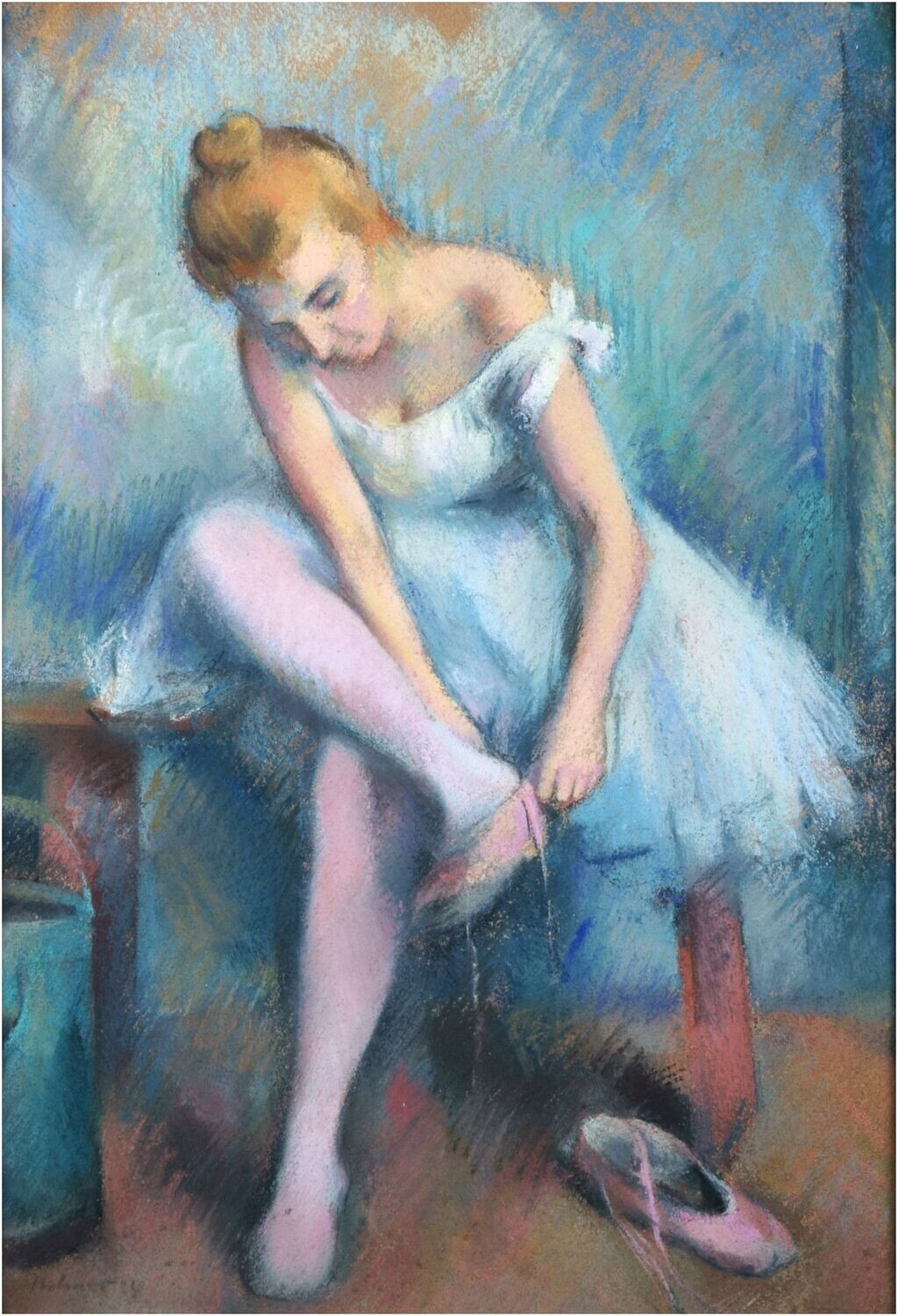Stohner, Karl (1894-1957), Ballerina im Ankleideraum, 1924
Karl Stohner(1894 Mannheim - 1957 Paris), Ballerina im Ankleideraum , 1924. Pastell auf Malkarton, 65 x 45 cm, 77,5 x 59,5 (Rahmen), unten links mit „Stohner“ signiert und auf „[19]24“ datiert. Hinter Glas im Goldstuckrahmen der Zeit.
- Malkarton leicht verzogen, im unteren Bereich minimal fleckig, Rahmen mit Alterspatina und Abriebspuren
Exposé als PDF
- Die Natürlichkeit der Kunstform -
Wir sehen eine Ballerina, die sich den rechten Ballettschuh anzieht, während der linke noch vor ihr auf dem Boden liegt. Gerade aus der Beiläufigkeit der Szenerie speist sich ihre Intimität: Die blonde junge Frau geht ganz in der Tätigkeit auf, sich für den Tanz vorzubereiten, ohne uns dabei zu gewahren, während wir in dem für das Publikum unzugänglichen Umkleideraum genau vor ihr situiert sind und sie beim Ankleiden betrachten. Auch wenn sie noch keinen Tanzschritt vollführt, liegt in der gezeigten Handlung eine anmutige Eleganz, die im Gegensatz zur einstudierten Kunstform des Tanzes ganz natürlich wirkt. Die junge Frau präsentiert sich eben nicht in formvollendeter Bewegung vor einem Publikum, sondern vollführt eine ganz alltägliche Handlung, ohne zu wissen, dass sie dabei betrachtet wird. Konzentriert, beinahe hingebungsvoll zieht sie den Ballettschuh über die Verse und bemerkt nicht, dass ihr dabei ein Träger des Tutus von der Schulter gerutscht ist, was den erotischen Moment der Szene noch verstärkt.
Karl Stohner hat die an Edgar Degas inspirierte Darstellung in kräftigen Pastelltönen ausführt. Das dominierende Blau und Türkis verleiht der Szene etwas magisch Geheimnisvolles und ist ebenso wie das Rosa der Strümpfe und Ballettschuhe den von Degas dargestellten Tänzerinnen entlehnt. Degas Farben sind allerdings kühler temperiert, was sich insbesondere im hellen pastos aufgetragenen Inkarnat zeigt. Hier hält die Lebensfülle Auguste Renoirs Einzug ins Bild und lässt die Tänzerin ganz aus Fleisch und Blut erscheinen. Karl Stohner, der die Pastelle von Degas und Renoir intensiv studiert hat, vermählt hier beide Künstler miteinander und schafft damit eine eigene Bildsprache.
Den Hintergrund hat er in breiten Strichlagen angelegt, die farblich von Weiß über Türkis bis Dunkelblau reichen. Es entsteht eine musterförmige dynamische Struktur, die die ruhig in-sich-gekehrte Haltung der Frau konterkariert. Der Fond nimmt gleichsam die Dynamik der Choreographie des Tanzes vorweg, auf den sich die Ballerina vorbereitet. Zugleich wird durch den Hintergrund der breite Pastellstrich als adäquates Malmittel thematisiert, die weiche fließende Eleganz der Tänzerin zu veranschaulichen.
zum Künstler
Entgegen dem Wunsch der wohlhabenden Eltern entschied sich Karl Stohner Maler zu werden. Sein Talent wurde vom Direktor der Mannheimer Kunsthalle, Fritz Wichert, entdeckt der ihn fortan förderte und Studienreisen unter anderem nach Paris finanzierte. Dort entdeckte er die Kunst von Degas, Cézanne und Renoir, die ihn in seinem Schaffen inspirierte.

